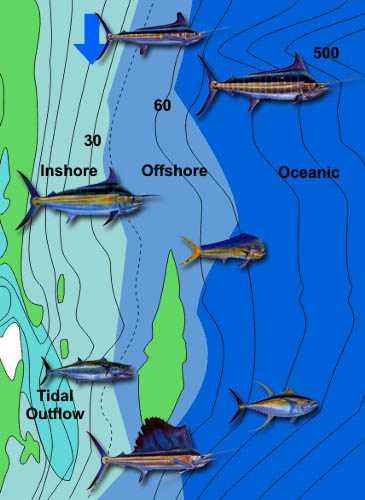04: Predator Profiles
Between The Lines - Ch 01: Profiles
|
Specifying a species as a gamefish is misleading, as all fish are gamefish if caught according to the ethics of the sport, and indeed a great many species are recognised by the IGFA as such. Indeed, the majority of fish species are predators as they hunt and feed on living organisms. On the other hand, even the most esteemed species such as marlin can become scavengers when the opportunity arises, so in reality, it is hard to classify the species into definite groups of predators and gamefish. The job at hand makes this chapter a bit easier as we are concentrating on gamefishing using skirted trolling lures. We will concentrate on the species most sought after using this method. The purpose of these early chapters is to gain an understanding that the many aspects of the sport create a jigsaw puzzle where everything involved is linked to everything else. With an understanding of how to come up with the questions will mean an understanding of the answers will be much clearer. Once again, we have our zone chart to the right. Let's first look at the inshore grounds because far more potential is there than many realise and they are often overlooked. This potential is based on the currents - areas that interfere with the flow of water such as reefs and islands, sudden changes in contours, both drop-offs and ridges and temperature differences. The greater the temperature differences over the shorter area the better. However, as each species has a preferred temperature range we will concentrate on temperatures from 18 to 26 degrees centigrade, with the optimum 25 to 26, though often fish will be found either side of what we believe to be their range. We will group all these factors (physical and temperature) together as 'structure'. Of course, there are many more signs and factors that guide towards increasing success, but that will be dealt with later. The inshore, or shallow grounds hold great potential since the systems of currents, reefs and water interchange are more concentrated. The species found here include mackerel and many other species that are similarly shaped. The fins are small and narrow. The tail is very small and solid. The teeth form a row of razor blades. This shape is built for speed but not for extended periods. It's more of a drag-racer than a four-wheel-drive. The eyes are quite small, a sign that the species feeds more during the day than night. The lateral line is distinct and well defined, an indication that vibration is very important to them.
Mackerels and similar species are generally found in the currents adjacent to the structure. In fact, most of the predators can be found in these areas, as this is not only where the food is but where it is easiest to feed on. Most, because this is not the case for blue marlin, Spearfish, albacore and several others.
The black marlin has the most solid bill of all the billfish species and it is also the most abrasive. The actual purpose of the bill is thought to aid water flow at speed, directional stability and to some extent, as a weapon for feeding, defence and aggression. The lateral line in juveniles is very well defined, but in adults, becomes embedded in the skin. It's proportionally large eyes is an indication of either nocturnal behaviour, or feeding at depth during daylight hours. This fish is designed to be an ultimate predator. Conserving energy while gliding through the ocean, its sensory organs conveying information from its surroundings and its ability to turn on an incredible burst of speed when necessary. Interestingly stomach content analysis show black marlin often feed on very small food items. It must pick these out individually as the structure of the gill systems are not designed to sift out these small items. Due to the highly migrational nature of the black marlin, they can be found in many of the zones throughout the Pacific and Indian Oceans. However, they are mainly found near shore and major reef structures. Many game and sports anglers ignore these places as they are considered too close to the shore to hunt large gamefish. Black marlin tend to congregate in year classes and size in various areas at different times of the year with the younger, smaller ones showing up first.
These fish are without a doubt the most beautiful fish we encounter with iridescent rainbow colours of great intensity. Built to eat, they have massive fins and streamlined shape. Mahi mahi are school fish that cooperate in balling up baitfish and massacring them. They are very powerful for their size as they spend much of their time fining in the currents on the prowl for food. They also seem to be highly intelligent as it is often hard to catch many from a school without changing tactics.
As with the other pack or school fish they may be found in the closer shallower zones if oceanic currents and eddies are pushed in. The main quarry of the deep blue for game anglers is the blue marlin. These are the toughest of all marlin, and are incredibly spectacular oceanic predators. They have large powerful fins, big eyes and their physical build is streamlined and muscular.
All these and the other predators inhabit the currents, along the edges where food is most plentiful and easiest to hunt. Many other species that inhabit the same waters are also worth considering. Important factors to note are that often many species of predators will be found in the same area feeding on the same bait species. Bait species are not specific food for individual predator species. All predators are opportunistic feeders, eating for the most part whatever they can easily catch. The size of food varies from minute to as much as 20 percent of the predator's weight. Often they will let other species do most of the work in balling up bait, while they hang back and wait for the wounded bait to drift into their range. Certainly, the major prize for any predator is finding wounded prey that is easily caught and eaten. Each of the species that we hunt certainly has a water temperature range that it prefers. However, you will find that you can catch them outside this range. In all cases difference in water temperature over a given distance, for example, 18 degrees to 22 degrees in two miles - is far more important than the actual temperature. Information as to specific temperatures can also be misleading as very few boats have calibrated gauges that read correctly on a specific or range of temperatures.
|





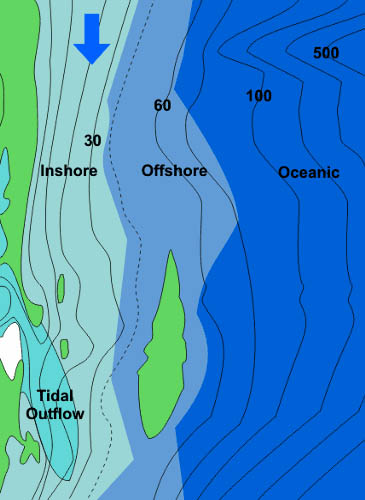 Let us continue to use the same sort of viewpoint on our target species - the predators. These observations are certainly not scientific; rather an attempt at understanding their distribution and obvious physical attributes to better help us improve making decisions on targeting them with appropriate gear and methods.
Let us continue to use the same sort of viewpoint on our target species - the predators. These observations are certainly not scientific; rather an attempt at understanding their distribution and obvious physical attributes to better help us improve making decisions on targeting them with appropriate gear and methods. In fact, all the predators we are discussing here have very well defined lateral lines that extend the full length of the body which indicates vibration is universally an important sensory organ. Another appealing and important characteristic that is universal with the predators is the sheer brilliance of the skin. The living fluorescent colours are breathtaking. The ability to change these colours is used for many purposes including camouflage, hunting, herding baitfish into tighter schools, communication with others of the same species and quite likely, mating displays.
In fact, all the predators we are discussing here have very well defined lateral lines that extend the full length of the body which indicates vibration is universally an important sensory organ. Another appealing and important characteristic that is universal with the predators is the sheer brilliance of the skin. The living fluorescent colours are breathtaking. The ability to change these colours is used for many purposes including camouflage, hunting, herding baitfish into tighter schools, communication with others of the same species and quite likely, mating displays.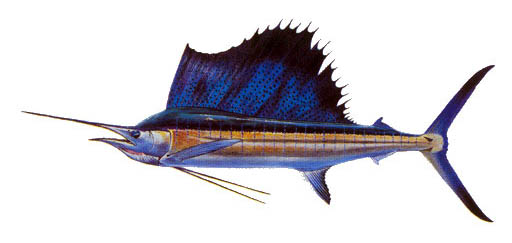 Another sought-after species in the inshore zone is the sailfish. It has a massive forked tail relative to its slender body size. It's huge dorsal, used among other things for brilliant colour displays, is to herd baitfish folds neatly into a socket along its back. The large anal fin aids in stability. The huge pectoral fins aid in direction change and stability in gliding through the water. With a long slender bill this fish is designed for speed, in fact, it's among the fastest fish we know of, although it is likely that all of the billfish are also amazing speedsters. Most of these fish do migrate and can be found anywhere, but are mainly targeted around the inshore structures discussed previously.
Another sought-after species in the inshore zone is the sailfish. It has a massive forked tail relative to its slender body size. It's huge dorsal, used among other things for brilliant colour displays, is to herd baitfish folds neatly into a socket along its back. The large anal fin aids in stability. The huge pectoral fins aid in direction change and stability in gliding through the water. With a long slender bill this fish is designed for speed, in fact, it's among the fastest fish we know of, although it is likely that all of the billfish are also amazing speedsters. Most of these fish do migrate and can be found anywhere, but are mainly targeted around the inshore structures discussed previously.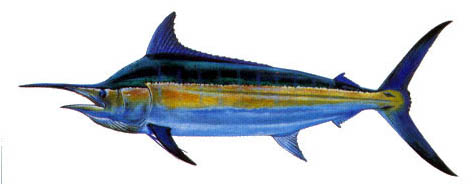 Black marlin are also found in these zones, especially the juveniles. These can be found right in against the shoreline if the currents are cooperative. The huge solid forked tail is designed for acceleration, the rest of the fins are designed for stability and gliding. The pectoral fins are rigid and do not fold in, just like the wings of an aircraft - a sign that this fish spends most itst's time gliding with the currents. It is built for slow steady gliding and short powerful bursts of speed.
Black marlin are also found in these zones, especially the juveniles. These can be found right in against the shoreline if the currents are cooperative. The huge solid forked tail is designed for acceleration, the rest of the fins are designed for stability and gliding. The pectoral fins are rigid and do not fold in, just like the wings of an aircraft - a sign that this fish spends most itst's time gliding with the currents. It is built for slow steady gliding and short powerful bursts of speed.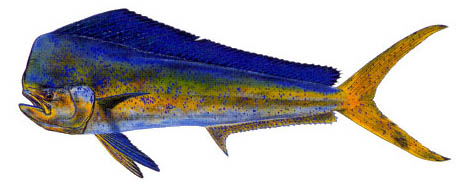 A great sign of tropical influence in the waters you are fishing is the presence of dolphin fish or mahi mahi. They are found in any clean warm oceanic water all around the world. Juveniles up to say, 75cm, are generally found inshore, while the giants (up to 2 metres or more) are usually found over the shelf in waters deeper than 100 fathoms. They are one of the fastest growing fish in the oceans and have a high fecundity, that is, they produce an enormous number of eggs during their lifetime. They are known best for adopting any floating object as a base. The more growth such as barnacles and weed the more chance mahi mahi have adopted it.
A great sign of tropical influence in the waters you are fishing is the presence of dolphin fish or mahi mahi. They are found in any clean warm oceanic water all around the world. Juveniles up to say, 75cm, are generally found inshore, while the giants (up to 2 metres or more) are usually found over the shelf in waters deeper than 100 fathoms. They are one of the fastest growing fish in the oceans and have a high fecundity, that is, they produce an enormous number of eggs during their lifetime. They are known best for adopting any floating object as a base. The more growth such as barnacles and weed the more chance mahi mahi have adopted it.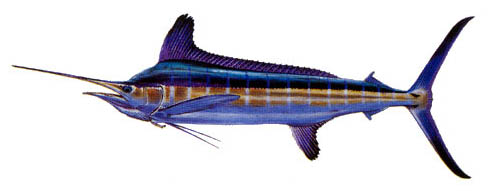 As we venture past the more common depths where black marlin are encountered we come to the striped marlin areas of offshore and ocean. Striped marlin are most commonly found in depths of 80 to 100 fathoms, although will often sweep in the to closer water on the edge of major eddies when water conditions and bait concentrations are right. These are the coldest water marlin with fish often found in temperatures less than 17 degrees centigrade. These fish are very slender with oversized fins. They are highly competitive pack fish, rarely found alone, and will aggressively compete with each other for food. As they are found in the greatest range of temperatures, they have the greatest variety of food species, although as with the other species of marlin, food size is often very small.
As we venture past the more common depths where black marlin are encountered we come to the striped marlin areas of offshore and ocean. Striped marlin are most commonly found in depths of 80 to 100 fathoms, although will often sweep in the to closer water on the edge of major eddies when water conditions and bait concentrations are right. These are the coldest water marlin with fish often found in temperatures less than 17 degrees centigrade. These fish are very slender with oversized fins. They are highly competitive pack fish, rarely found alone, and will aggressively compete with each other for food. As they are found in the greatest range of temperatures, they have the greatest variety of food species, although as with the other species of marlin, food size is often very small.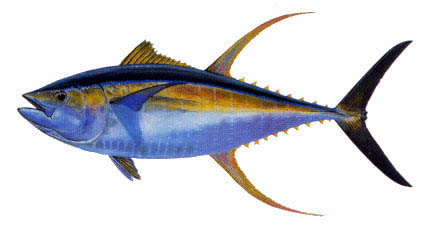 Once we get out into the deep blue oceanic zone, the depths beyond 100 fathoms we find the most powerful species such as the yellowfin tuna. This is an open ocean predator found along the leading edges of oceanic currents. It is built for strength and speed with power and stamina enough to prove a very tough opponent. We often talk of the ratio of fish weight to line class, and this is one where the results are often not very high. Even a fish that equals line class is considered good going, whereas the equivalent effort with a black marlin would mean a fish weighing at least five times the line class. Yellowfin are all muscle. Yellowfin are also a school fish, though the larger ones are often found solo or in small groups, possibly as they are the only ones remaining out of a larger school.
Once we get out into the deep blue oceanic zone, the depths beyond 100 fathoms we find the most powerful species such as the yellowfin tuna. This is an open ocean predator found along the leading edges of oceanic currents. It is built for strength and speed with power and stamina enough to prove a very tough opponent. We often talk of the ratio of fish weight to line class, and this is one where the results are often not very high. Even a fish that equals line class is considered good going, whereas the equivalent effort with a black marlin would mean a fish weighing at least five times the line class. Yellowfin are all muscle. Yellowfin are also a school fish, though the larger ones are often found solo or in small groups, possibly as they are the only ones remaining out of a larger school.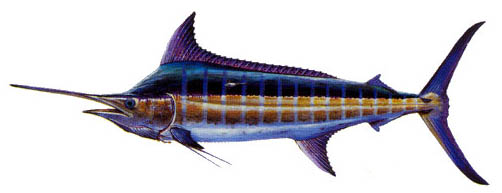 The blue marlin is one of the few species with a double lateral line so it can pick up harmonic vibrations at great distances. Rarely are they found in water less than 100 fathoms.
The blue marlin is one of the few species with a double lateral line so it can pick up harmonic vibrations at great distances. Rarely are they found in water less than 100 fathoms.